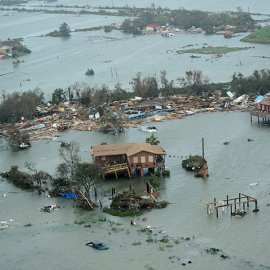Flood Insurance
-
English
-
ListenPause
[intro music] Welcome to World Ocean Radio… I’m Peter Neill, Director of the World Ocean Observatory. We are all aware of the devastating consequences of extreme weather on coastal communities, in the United States and around the world. We have seen the pictures of flooded homes, destroyed businesses, washed-out neighborhoods, and makeshift shelters for those whose very livelihoods have been inundated physically, financially, and psychologically. These scenes become more frequent as the incidence of such storms, the hurricanes and typhoons, increases with exponential damage and destruction. The situation has brought into question many things, from understanding the causes of such events to evaluating our defenses to re-building afterwards, particularly with the knowledge that such storms are very likely to happen again. In the US, planning and reparation for such coastal damage has been administered under a National Flood Insurance Program that since 1978 has paid more than $38 billion in claims. The program is based on agreement with local communities intended to reduce flood risks to new construction and to provide insurance against such risks in zones that have been mapped as special hazard areas on official rate maps. The Program was meant to be self-supporting, although in 2003 the US Government and Accounting Office found that repetitive loss properties cost the American taxpayer about $200 million a year. To cover those losses, the program borrows from the US Treasury. This is a broken system. And it will only get worse as extreme weather and sea level rise increase the incidence of events and the levels of destruction. In 2014 the US Congress passed a bill entitled the Homeowner Flood Insurance Affordability Act that over-turned previous reform legislation that required premiums to actually reflect the real risk of flooding leading to a certain increase in rates. The requirement that realistic actuarial rates be calculated and charged were “delayed,” possibly up to four years, meaning that the present insured will remain covered with subsidized rates that don’t even come close to real costs. So, what is wrong with this picture? First, the program historically has already proven inadequate to its mission, amassing irresponsible debt. Second, the data on which coverage is issued and rates established does not reflect the recent increase in extreme weather events. Third, updating the data and reforming the rate structure, while understood as necessary steps, has been postponed by elected representatives for fear of political backlash. Fourth, the Program continues to advertise for new clients in the very same zones that have proven vulnerable again and again, thereby increasing the probability of increased payouts after the next storm. Fifth, the private insurance companies are nowhere to be seen, clearly understanding that there is no financial viability whatsoever in such coverage. Sixth, the American taxpayers who do not live in these coastal areas are footing the bill for those who do, private waterfront property owners, often second homes, being underwritten by the public who don’t even know that this situation is ongoing. And there’s more. When these insurance claims are paid, the funds do not necessarily guarantee that the property is better prepared to survive the next challenge. Yes, in many cases, new construction and re-construction may be required to be elevated to allow future flooding to pass through, but these storms with their powerful winds and waves have little or no respect for these half-baked landside measures. They will take these buildings too, rip them to pieces, and suck the sand or mud or rock on which they’re built back into the sea again without remorse. Finally, how do we plan for what’s to come? After Superstorm Sandy, government made some attempts to persuade impacted coastal dwellers to accept reparation and incentive to not rebuild but build anew in another place. In some areas of the highest vulnerability, restoration and new development was to be forbidden. Those damaged were obviously twice upset, by the tragedy itself and again by the prospect that what they had could not be replaced. Some agreed. Some did not. The resultant political outcry by all explains the diluted resolve and government confusion about how future protection might be justified. Denial is no solution. These storms will come again. The sea is rising and will rise some more. The place where sea and land meet, will come under further attack by natural elements the force of which will not always respond to sea wall solutions, past politics, patterns of what was, inadequate regulation, or a bankrupt government insurance plan. There will be change. The ocean will make it so. We will discuss these issues, and more, in future editions of World Ocean Radio. [outro music]
In the United States, planning and reparation for coastal flooding and damage has been administered under a National Flood Insurance Program that since 1978 has paid more than $40 billion in claims. In this episode of World Ocean Radio we outline some of the reasons why the program is not working, especially as extreme weather becomes more prevalent and levels of destruction more severe.
Do you prefer the written word? Head on over to Medium.com/@TheW2O.
About World Ocean Radio
World Ocean Radio is a weekly series of five-minute audio essays available for syndicated use at no cost by college and community radio stations worldwide. Peter Neill, Director of the World Ocean Observatory and host of World Ocean Radio, provides coverage of a broad spectrum of ocean issues from science and education to advocacy and exemplary projects.
Image credit:
© Ho New / Reuters
- Login to post comments



